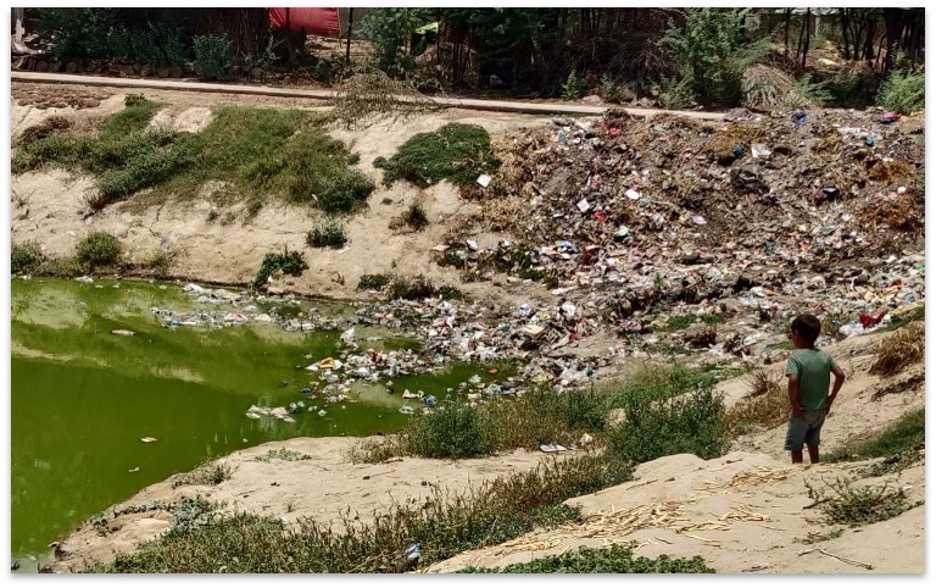As the sun rises over the dusty fields of Haryana, a farmer walks to his tube well, hoping it will still yield the precious water his crops desperately need. Miles away, in a bustling village, women gather around a once-thriving pond, now little more than a muddy depression littered with garbage. These scenes, playing out across India's breadbasket state, tell a story of a looming crisis - one that threatens not just livelihoods, but life itself. Haryana, with more than 70% rural population, is deeply dependent on water. Water is central to the lives of all its people, used not only for daily needs but also for agriculture and cattle farming. Despite this dependence, there are no all-season rivers in the state, leaving it mostly reliant on rains, groundwater, and water from other states.
Challenges faced by Haryana
Historically, the people of Haryana created man-made sarovars (ponds/lakes) to collect and conserve rainwater and recharge groundwater. However, with increased unplanned development in rural areas and added subsidies on tube wells and metered electricity, dependence on tube wells for agriculture and daily use has increased exponentially. More than 65% of agricultural land in Haryana is now irrigated by tube wells.
This extensive use of tube wells has caused groundwater levels to dip alarmingly. Currently, 88 out of 142 blocks (61%) in the state are in the over-exploited category, with 3,041 villages facing a water crisis. The situation in some districts like Hisar, Panipat, and Bhiwani is so dire that certain villages boycotted the 2019 general elections over unresolved water scarcity issues.
As tube wells gained prominence, the once-lifeline sarovars of rural areas fell into neglect, turning into garbage dumps and encroached land. Meanwhile, the demand for water continues to rise, especially in critical and over-exploited areas, making the situation seem irreversible.
Fig: Polluted sarovar in Palwal district, Haryana
Mission Amrit Sarovar: A National Initiative
The situation in Haryana mirrors a broader crisis faced by many states grappling with water scarcity due to population growth, pollution, and climate change. Recognizing the severity of the issue, both central and state governments have implemented various schemes over the last few years to ensure water conservation across the country. One such scheme is the Mission Amrit Sarovar, launched by the Hon’ble Prime Minister, Shri Narendra Modi in April 2022, aimed at rejuvenating 75 sarovars in each district of the country.
Fig: The Hon’ble Prime Minister, Narendra Modi launching Mission Amrit Sarovar in April 2022
Haryana started the implementation of Mission Amrit Sarovar in April 2022 with an aim to rejuvenate 1,650 Sarovars (75 in each of the 22 districts) in the state by August 15, 2023. To rejuvenate and restore these ponds, there were four activities that were performed:
- Dewatering
- Desilting
- Excavation
- Construction of Embankments
To achieve this goal, the state unlocked budgets worth ₹300 crore. The Pond Authority was energized as the nodal body to lead these efforts, coordinating between five other departments: Panchayati Raj, Rural Development, Directorate of Urban Local Bodies, Fisheries, and HAREDA. To enhance coordination, bi-weekly coordination meetings were held, and robust mechanisms for data collection were put in place. Additionally, over 30 data-backed state-level reviews were conducted to ensure timely and seamless debottlenecking.
To ensure seamless district-level coordination in order to achieve this target, The Hon’ble Chief Minister of Haryana brought in the Chief Minister’s Good Governance Associates (CMGGA) program in March 2023 with the responsibility of achieving this target within the stipulated time. The CMGGA team laid out an extensive theory of change outlining the target, the approach and the validation method to be able to achieve the targets timely.
The CMGGA team ensured robust district-level monitoring of the targets laid out at the state-level through extensive pond-level monitoring and regular field visits. Over 1,200+ field visits were carried over to ensure active on-site debottlenecking by the CMGGAs with the various local authorities. Regular district-level reviews were held headed by the District Collector (DC) and momentum generation was carried out through awarding the best performing district functionaries. As a result of this, the pond target completion rate went up from 89 sarovars/month in April 2023 to 120 sarovars/month. Additionally, the enhanced water-holding capacity of these ponds has proved invaluable for improved water management during monsoons and floods.
The coordinated efforts between state headquarters and districts led to Haryana achieving its target in June 2023, two months ahead of the national deadline. As of January 2024, Haryana has rejuvenated more than 2,100 Sarovars, achieving 125% of the initial target. The enhanced water-holding capacity of these ponds has proved invaluable for improved water management during monsoons and floods.
Beyond Rejuvenation: Amrit+ & Amrit++
While the Amrit Sarovar scheme made significant strides in rejuvenating water bodies, there remained a concern that these Sarovars could once again fall prey to encroachment and become dumping grounds for garbage. This would have rendered the scheme successful only on paper, failing to achieve its true spirit. To address this challenge and ensure the long-term sustainability of the rejuvenated Sarovars, the CMGGA team, in collaboration with the Chief Minister's office, conceptualized and designed the Amrit+ and Amrit++ initiatives. The core objective was twofold: to enhance community ownership and participation, and to monetize the Sarovars, transforming them into income sources for their respective panchayats.
Amrit+: Beautification and Community Engagement
To ensure long-term sustainability and prevent the rejuvenated sarovars from falling back into neglect, the CMGGA team, in collaboration with the Chief Minister's office, conceptualized the Amrit+ initiative. This program focuses on beautification and community engagement. The following activities were carried out:
- Walkways
- Solar Lights
- Benches
- Plantations
- Formation of Sarovar Seva Samuh (Community adoption groups)
Beautification efforts included developing walkways, installing solar lights and benches, and extensive plantations around the sarovars. These enhancements have significantly improved accessibility for local residents, providing them with much-needed recreational spaces. For instance, in Ghikara Village of Charkhi Dadri, predominantly inhabited by marginalized socio-economic communities, residents have testified to the increased aesthetic and recreational value of the area. In Nuh, the Malab Pond has become a local attraction, even featuring in the itineraries of senior state officials visiting the district.
Under community engagement, Sarovar Sewa Samuhs (community adoption groups) were formed to ensure the maintenance and upkeep of these ponds. These groups were responsible for creating awareness on the importance of the well-being of Sarovars in their area, ensuring that issues related to Sarovars are discussed in their panchayat meetings, and there is keen community involvement in their village to keep these Sarovars clean. Along with this, a Pond Festival calendar was created, including days of national significance to ensure the pond was central to the community coming together.
The impact of Amrit+ has been substantial, with over 300 Amrit+ ponds evolving into community hubs, attracting people of all ages for various recreational activities.
Amrit++: Economic Viability and Income Generation
The Amrit++ initiative focuses on the economic sustainability of the sarovars. Under this initative, rejuvenated sarovars are being auctioned for pisciculture and local tourism activities like boating.
The financial impact has been remarkable, with panchayats seeing significant increases in income from more than 130 of the Amrit++ sarovars. Panchayats have seen a significant increase in their income, ranging from an average of ₹ 2 lakh to a maximum of ₹15 lakh.
The success story beyond water management
Haryana's journey from water crisis to innovative water management represents a holistic and forward-thinking approach to one of the most pressing challenges of our time. The success is evident not just in numbers - over 2,100 Sarovars rejuvenated, 300+ Amrit+ ponds, and 130+ Amrit++ ponds - but in the tangible impact on people's lives. This model goes beyond mere conservation, encompassing community engagement & economic sustainability. It offers valuable lessons for other regions facing similar challenges, demonstrating that with political will, community participation, and innovative thinking, it is possible to turn the tide on water scarcity.
As we look ahead, Amrit Sarovar and its extensions stand as a testament to what can be achieved when government initiatives align with the needs of the community & environment. While challenges remain, the path forged by Haryana offers hope and a practical roadmap for sustainable water management, reminding us that in the face of environmental crises, innovative solutions coupled with community engagement can pave the way for a more resilient and water-secure future.
This blog is part of the Amrit Series, where we bring to you success stories of large scale impact through our work across domains and states. You can learn more about Amrit Sarovar here.


